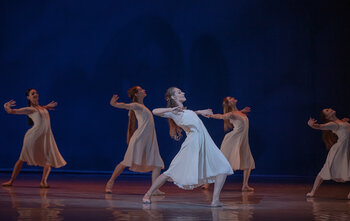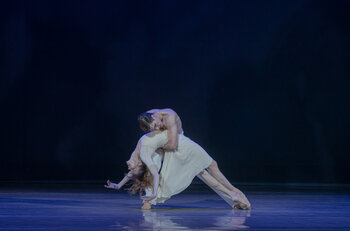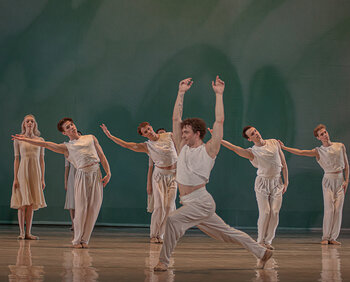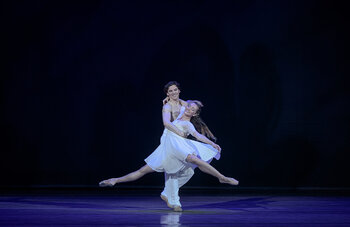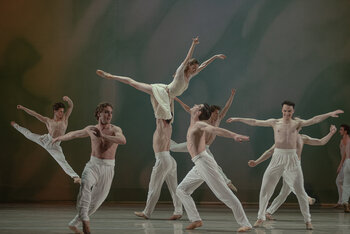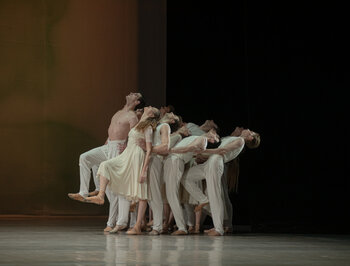Upcoming shows
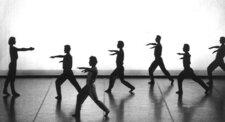
Ballet by John Neumeier
Hamburg Ballett
Ballet to music by Antonín Dvorak (Serenade in E Major, Op. 22).
Choreography and costumes by John Neumeier
***
April 1991, in the middle of the work - I have started the choreography of Dvorak's String Serenade - the words "spring and fall" come to my mind. Would that be a title? I remember that the English lyricist Gerard Manley Hopkins titled a poem that way. He wrote it, as I read it, in autumn, in September 1880. Dvorak composed the serenade in spring, in May 1875 - not a big time gap!
"Spring and Fall", in English an ambiguous title: the most direct translation is - "jump and fall" or even more moving, even more active "let`s jump and fall". Basically an ideal title for a modern or new dance piece. "Fall and recovery" are the two basic principles from which movement developed for Doris Humphrey. She called it the "arc between two deaths," the death of immobility and the death of surrendering oneself entirely to gravity, and built her technique on it, which was later continued by Jose Limon.
"Spring and fall," also means spring and fall, when the buds burst open and the withered leaves fall. Unlike in German, the two words in English have a whole series of other meanings that give the sentence a metaphysical dimension and were certainly thought of by Hopkins, "spring" also means source, spring, mainspring, origin, and "fall" can be translated just as with fall, waterfall, decay, as with fall from grace. The course of the year, the course of life - also an "arch between two deaths", the history of mankind (after the fall of the first man), Hopkins surely means all this with his title: "Spring and Fall".
In the next room, parallel to our rehearsals, one of the last ballets of Antony Tudor is being rehearsed. He choreographed it to Dvorak string quartets three years before his death. "The Leaves are Fading," he called it: The Leaves are Withering, The Same Thought - is it because of Dvorak and the similar mood in the music? He could just as easily have called it "Spring and Fall." From the perspective of age, Tudor has created a piece about love, friendships, spring feelings, about being young. Contrary to the wistfulness implied in the title, it is full of freshness and cheerfulness, an atmospheric and only marginally anecdotal ballet. The stage set is an abstracted landscape. Trees, flowers, foliage, nature.
Dvorak loved nature, and it was so important to Hopkins that he filled his diary with detailed, minute observations of nature, with descriptions of cloud formations. Trees, plants, water vortices… "spring and fall."
Nature - nature as a mirror of human life, which is not my theme, not in this ballet. My ballet is entirely about the dancer and the dancing. Hopkins' poem to a little girl who mourns her own transience without knowing it, purely instinctively - that is not my program. I am touched by the ambiguity of the almost abstract juxtaposition of words. It is this concise, associative, dance-like title that keeps coming back to me. I like Hopkin's unusual sentence and word constructions, his power of language, his rhythm - the poem is in "leap rhythm," what a dynamic of language! His poetry remained alien to his contemporaries; it was too experimental and idiosyncratic. The form of the poem is fascinating, the free use of language and syntax, the word experiments, the virtuoso play with sound and rhythm, the dense texture and musical structure. Hopkins has written extensively on music and the nature of musical composition. He has written two books on harmony and counterpoint, he has invented his own song melodies. His real music is the poems.
Music of language, language of movement, movement of music, moving music-dance! This is the theme. I will call the ballet "Spring and Fall".
John Neumeier

